Last Updated on February 20, 2025 by Mark S. Taylor
Ever noticed a tiny chip or scratch on your car and felt that sinking feeling? I’ve been there. A few months ago, I spotted a nasty rock chip on my hood, and ignoring it wasn’t an option. That’s when I learned how to touch up car paint the right way—without making it worse. Whether it’s a small scratch or a bigger patch, fixing paint damage at home is easier than you think. In this guide, I’ll walk you through simple, step-by-step tips to restore your car’s paint like a pro. Let’s get started!
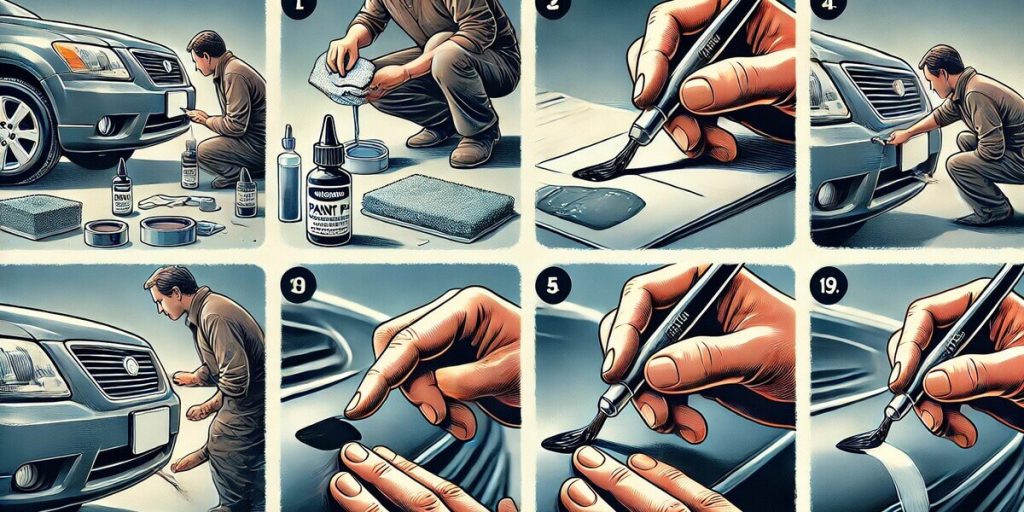
Contents
Understanding Car Paint Damage
Your car’s paint job isn’t just about looks—it protects the metal underneath from rust, weather, and everyday wear. But let’s be honest: seeing a fresh scratch or chip can be frustrating. I remember parking too close to a bush once, thinking, “It’s just a few leaves,” only to find my door covered in tiny scratches. If you’ve been there, don’t worry—paint damage happens to everyone. The good news? Most of it can be fixed at home.
Types of Paint Damage
Car paint damage comes in different forms, and knowing what you’re dealing with helps you choose the right fix. Here’s a quick breakdown:
- Chips: Small dings caused by rocks or road debris hitting the car. These expose the metal underneath, leading to rust if ignored.
- Scratches: Ranging from light surface marks to deep gouges that reach the primer. Light scratches can be buffed out, while deeper ones need touch-up paint.
- Peeling: If the clear coat starts lifting, the paint beneath can deteriorate. This usually happens due to sun exposure or aging.
- Fading: Over time, UV rays break down the paint, making it look dull or discolored. A good wax or polish can help restore some shine.
Assessing the Severity: DIY or Pro Help?
Not all damage needs a body shop visit. Here’s a simple way to decide:
- DIY Fix: Light scratches, small chips, and minor fading can be handled with a touch-up kit and some patience. If the damage is smaller than a dime, you’ve got this!
- Professional Help: If you see peeling paint, deep scratches exposing bare metal, or large areas of damage, a pro might be your best bet. Fixing it wrong could make things worse.
So, before you panic over that scratch or chip, take a deep breath. With the right tools and a little know-how, you can get your car looking great again. Up next, let’s find the perfect touch-up paint for your ride!
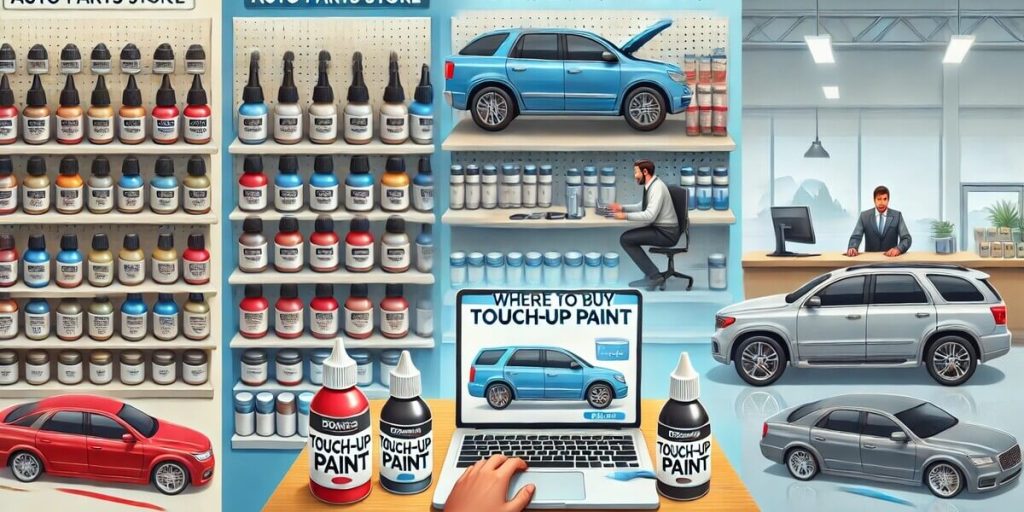
Where to Buy Touch-Up Paint for Your Car
Buying the right touch-up paint can be tricky. I learned this the hard way when I tried fixing a small chip on my car. I picked a color that looked close enough—only to end up with a patch that stood out like a sore thumb. Lesson learned: always check your car’s paint code first.
Finding the Right Paint Match
Your car’s color isn’t just “red” or “blue”—it has a unique paint code. You can find this code:
- Inside the driver’s side door
- Under the hood
- In the owner’s manual
Once you have the code, you can buy an exact match instead of guessing.
Best Places to Buy Touch-Up Paint
Here’s where you can get touch-up paint:
- Auto Parts Stores (AutoZone, O’Reilly, etc.): Good for quick buys but limited in stock.
- Online Retailers (Amazon, PaintScratch, etc.): Best for variety and custom-mixed colors.
- Dealerships: Guaranteed color match, but pricier.
For fast and cheap, go to a local store. For the perfect match, order online or visit a dealership.
Touch-Up Kit vs. Buying Paint Separately
Should you get a full touch-up kit or just the paint?
- Kits: Include paint, brushes, and clear coat—great for beginners.
- Individual Supplies: If you already have tools, just buy the paint.
For my first fix, I used a kit. It made things easier. If you’re confident, buying paint separately can save money.
Now that you have the right paint, let’s talk about how to apply it like a pro!
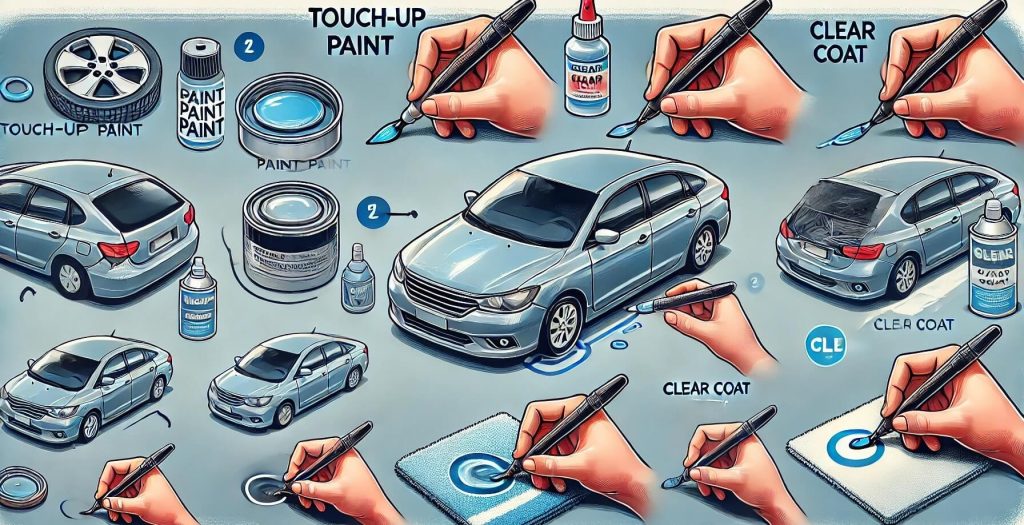
How to Apply Touch-Up Paint to Your Car
Touching up car paint is like giving your car a little TLC. It’s a small fix that can make a big difference. I remember the first time I tried it—I was nervous about messing up, but once I followed the right steps, the results were surprisingly good. If you take your time and do it right, you’ll barely notice the repair. Here’s how to do it properly.
Step 1: Preparing the Surface
Before you grab that touch-up pen or brush, prep work is key. A clean surface helps the paint stick better and blend smoothly.
- Wash the damaged area with soap and water to remove dirt and grime.
- Let it dry completely.
- Use rubbing alcohol or acetone to wipe away any old paint, wax, or grease.
👉 Quick Tip: If the damage has rough edges, lightly sand it with fine-grit sandpaper for a smoother finish.
Step 2: Using a Touch-Up Paint Pen
Touch-up pens are great for small chips and thin scratches. The key is applying thin, even layers.
- Shake the pen well before use.
- Gently press the tip onto the scratch and apply the paint in light, dabbing motions—don’t press too hard.
- Let the first coat dry before adding another layer if needed.
👉 Best Practice: Avoid overfilling the scratch. Too much paint can create a raised blob that’s hard to fix later.
Step 3: Applying Paint with a Brush
For larger areas, a fine-tip automotive touch-up brush works better than a pen. The goal is smooth, even coverage.
- Dip the brush lightly into the paint—less is more.
- Apply in thin, feathered strokes to blend with the surrounding paint.
- Let each layer dry before adding another.
👉 Blending Tip: Use a steady hand and soft strokes to avoid harsh paint edges.
Step 4: Adding Clear Coat After Touch-Up Paint
Once the paint dries, a clear coat locks it in and gives it a glossy, factory-like finish.
- Use a small brush or pen to apply a thin layer of clear coat over the repaired area.
- Let it dry for at least 24 hours before touching or polishing.
👉 Why It Matters: Clear coat protects the paint and helps it blend with the rest of your car’s finish.
With patience and the right technique, you can make those chips and scratches disappear almost like magic. Next, let’s talk about how to smooth out touch-up paint for a flawless look.
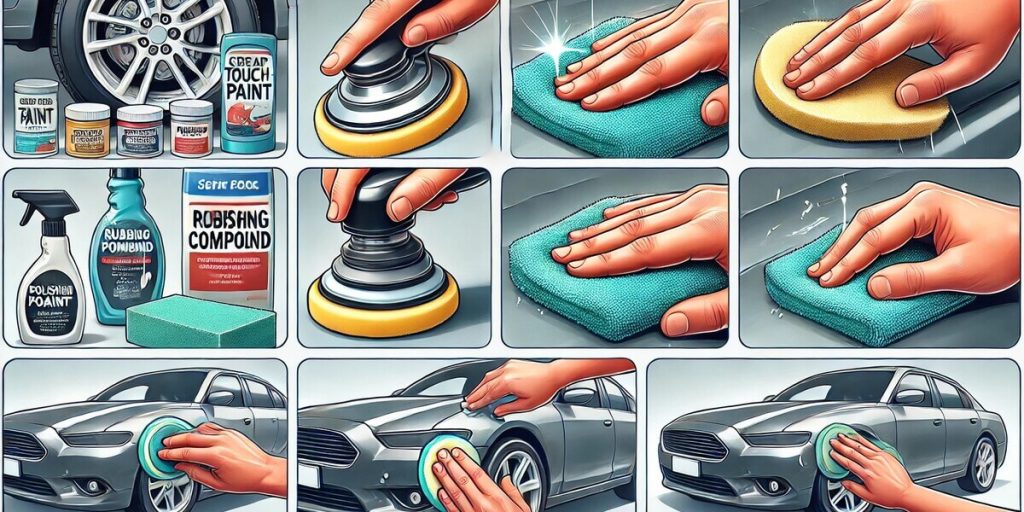
How to Smooth Out Touch-Up Paint on a Car
So, you’ve touched up your car paint, but now the spot looks uneven or rough? Don’t worry—it happens to the best of us. The first time I used a touch-up pen, I ended up with a tiny, raised blob that caught the light in all the wrong ways. Luckily, fixing it is easier than you think. With the right techniques, you can blend the paint smoothly for a seamless finish.
Without Sanding: Using Rubbing Compound
If your touch-up paint looks too thick or textured, rubbing compound is your best friend. It gently levels out the surface without damaging the surrounding paint.
- Let the touch-up paint fully cure (usually 24-48 hours).
- Apply a small amount of rubbing compound to a microfiber cloth.
- Rub the area in light, circular motions until the surface feels even.
- Wipe clean with a soft cloth.
👉 Why This Works: Rubbing compound smooths out the excess paint and restores a uniform finish.
At-Home Methods: Polishing for a Seamless Look
If the repaired area still stands out, polishing can help blend the edges and add shine.
- Use a mild car polish (not wax) on the repaired spot.
- Apply with a foam applicator or microfiber cloth in gentle circles.
- Buff the area lightly until it blends with the rest of the car.
👉 Pro Tip: A dual-action polisher can make blending easier, but hand polishing works too.
Common Mistakes: Fixing Uneven Touch-Up Paint
Sometimes, things don’t go as planned. Here’s how to fix common issues:
- Paint too thick? Use rubbing compound to gently buff it down.
- Color doesn’t match? You may need to reapply with a thinner layer.
- Paint edges too harsh? Feather them out with polish for a smoother transition.
With a little patience, you can make your touch-up job nearly invisible. Next, let’s talk about fixing mistakes like excess paint or bad touch-up jobs.
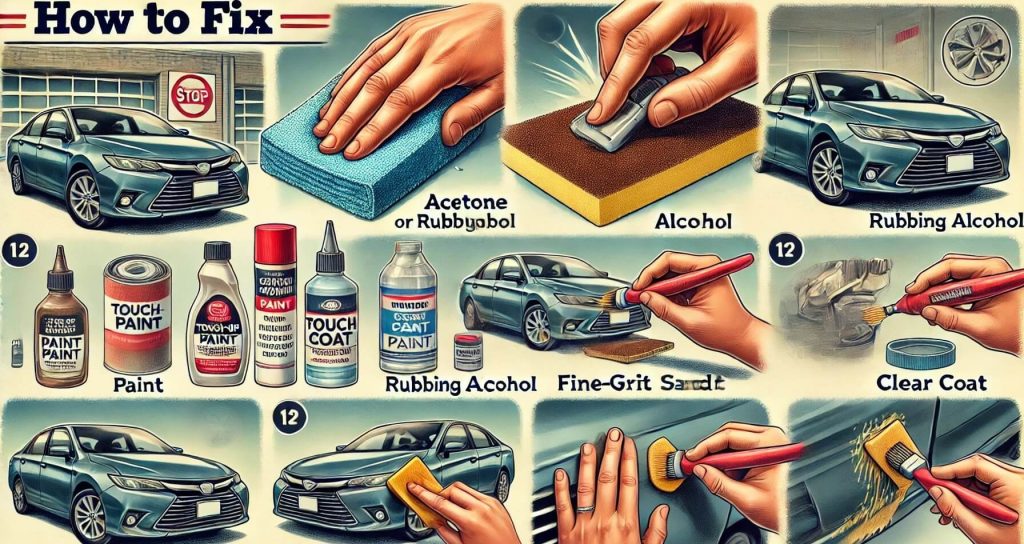
Fixing Touch-Up Paint Mistakes
Let’s be honest—touching up car paint doesn’t always go as planned. I’ve had my fair share of paint blobs, mismatched colors, and streaky finishes. The good news? Most mistakes are fixable. Whether you applied too much paint or ended up with a rough finish, here’s how to correct it without making things worse.
How to Remove Excess Touch-Up Paint from Your Car
If the touch-up paint is too thick or uneven, you don’t have to live with it. A little patience and the right technique can remove the excess without harming your car’s original paint.
- Nail polish remover (non-acetone) or rubbing alcohol works well for fresh mistakes. Apply a small amount to a microfiber cloth and gently rub the area.
- For older, hardened paint, use acetone sparingly. Dab it onto the excess paint and carefully wipe away the buildup.
- Clay bars can also help remove stubborn paint without affecting the surrounding area.
👉 Quick Tip: Always test on a hidden spot first to make sure it doesn’t damage the clear coat.
How to Fix a Bad Touch-Up Paint Job
If the paint looks bumpy, uneven, or too noticeable, here’s how to smooth it out:
- For raised or rough spots: Lightly sand the area with 1,500-2,000 grit sandpaper, then polish it back to a shine.
- For harsh edges: Use a rubbing compound to blend the touch-up paint into the surrounding area.
- If the color is off: You may need to remove the bad paint and start over with a better match.
👉 Pro Tip: When reapplying touch-up paint, use thin layers and let each coat dry completely before adding more. This prevents streaks and buildup.
With the right fixes, you can turn a bad touch-up job into a smooth, factory-like finish. Next, let’s go over the best techniques for touching up larger areas of car paint.
Tips for Touching Up Large Areas of Car Paint
Touching up a small scratch is one thing, but fixing a large area? That’s a whole different challenge. I learned this the hard way when I tried to repair a sun-faded patch on my car’s hood with a tiny brush—it ended up looking worse than before! For bigger sections, you need the right tools and technique to blend the paint seamlessly.
When and How to Touch Up Large Areas
If the damage covers a wide spot—like a door panel or hood—spot-fixing won’t cut it. Instead, you’ll need to blend the paint into the surrounding area for a natural look.
- Prep is everything. Clean the area thoroughly and lightly sand the edges of the damaged paint to create a smooth transition.
- Work in thin layers. Apply multiple light coats instead of one thick layer to prevent drips or uneven coverage.
- Allow drying time. Let each coat dry completely before adding the next to avoid streaks or buildup.
👉 Pro Tip: If the damaged area is bigger than a credit card, consider repainting the entire panel for a professional finish.
Spray vs. Brush: What Works Best for Large Areas?
Choosing the right application method makes a huge difference.
- Spray paint: Best for large sections because it creates a smooth, even finish. Great for blending.
- Brush application: Works well for small chips, but on bigger areas, it can leave visible brush marks.
👉 Best Practice: If using spray paint, keep the can 6-8 inches away and use a sweeping motion to avoid drips.
Preventing Mismatched Color Issues
Ever seen a car with a patch that’s just slightly off in color? That happens when the paint doesn’t match perfectly.
- Use the exact paint code. Even small differences in shade can be noticeable in sunlight.
- Blend into the surrounding paint. Don’t just paint the damaged spot—feather the edges for a seamless look.
- Finish with clear coat. This not only protects the paint but also helps match the original factory shine.
👉 Quick Fix: If the new paint still looks off, buff the area with a rubbing compound to help it blend better.
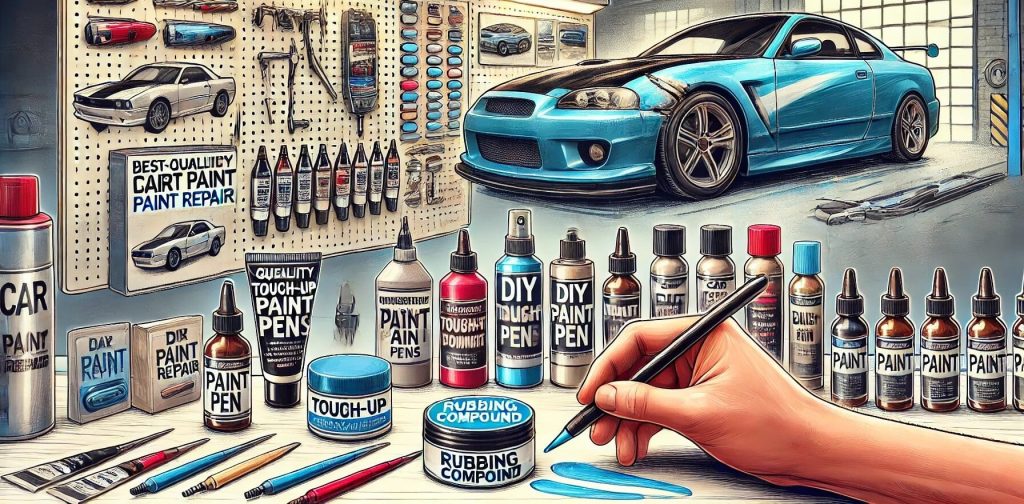
Best Products for Car Paint Repair
Fixing car paint is easier when you have the right tools. I’ve tested different products over the years—some worked like magic, others were a waste of money. If you want smooth, professional results, these are the best products to use.
Best Touch-Up Paint Pens for Cars
Touch-up pens are great for small chips and scratches. They’re easy to use and help prevent rust.
- ACDelco GM Touch-Up Pen – Perfect for GM cars with a factory color match.
- Toyota Genuine Touch-Up Pen – Best for Toyota owners who want an exact match.
- Dupli-Color Scratch Fix Pen – Works on most brands and has both a pen tip and a brush.
👉 Quick Tip: Shake the pen well before using to avoid uneven color.
Best Rubbing Compound for Car Paint Repair
A rubbing compound smooths rough paint and blends it into the surrounding area.
- Meguiar’s Ultimate Compound – Great for blending and removing imperfections.
- Turtle Wax Rubbing Compound – Budget-friendly and works on minor paint issues.
- 3M Scratch Remover – Ideal for fine scratches and touch-up paint blending.
👉 How to Use: Apply with a microfiber cloth and rub in circles for the best finish.
Recommended DIY Car Paint Repair Kits
If you’re fixing multiple spots or a large area, a kit makes it easier.
- Color N Drive Touch-Up Kit – Comes with paint, clear coat, and a blending solution.
- Dupli-Color Paint Shop Kit – Best for bigger repairs with spray-on application.
- Dr. ColorChip Paint Kit – Simple dab-and-wipe system for fast chip repairs.
👉 Why Use a Kit? Everything you need is included, so you don’t have to guess.
FAQs: Common Questions About How to Touch Up Car Paint
How to fix chipped car paint?
Clean the area, apply thin layers of touch-up paint, and finish with a clear coat. Let each layer dry before adding the next to avoid buildup.
Can you blend touch-up paint on a car?
Yes, apply the paint in thin, feathered strokes. Once dry, use rubbing compound to smooth out edges. This helps blend it with the surrounding paint.
How long does touch-up paint take to dry?
Touch-up paint dries in 30 minutes but takes 24-48 hours to fully cure. Wait at least a day before applying clear coat or washing your car.
Is clear coat necessary after touch-up paint?
Yes, clear coat protects the paint and adds shine. Apply a thin layer over the dried touch-up paint and let it cure for at least 24 hours.
How to remove a bad touch-up paint job?
Use acetone or rubbing alcohol for fresh paint. For dried paint, lightly sand with 1,500-grit sandpaper and reapply in thin, even layers.
My Final Thoughts on How to Touch Up Car Paint
If you love keeping your car looking its best, learning how to touch up car paint is a game changer. It’s a simple, affordable way to fix small chips and scratches before they get worse. But if the damage is large or deep, a professional repair might be the better option.
From cleaning the surface to applying clear coat, every step matters for a smooth, lasting finish. Take your time, use thin layers, and blend carefully. With patience and the right tools, you can make your touch-up job nearly invisible.
